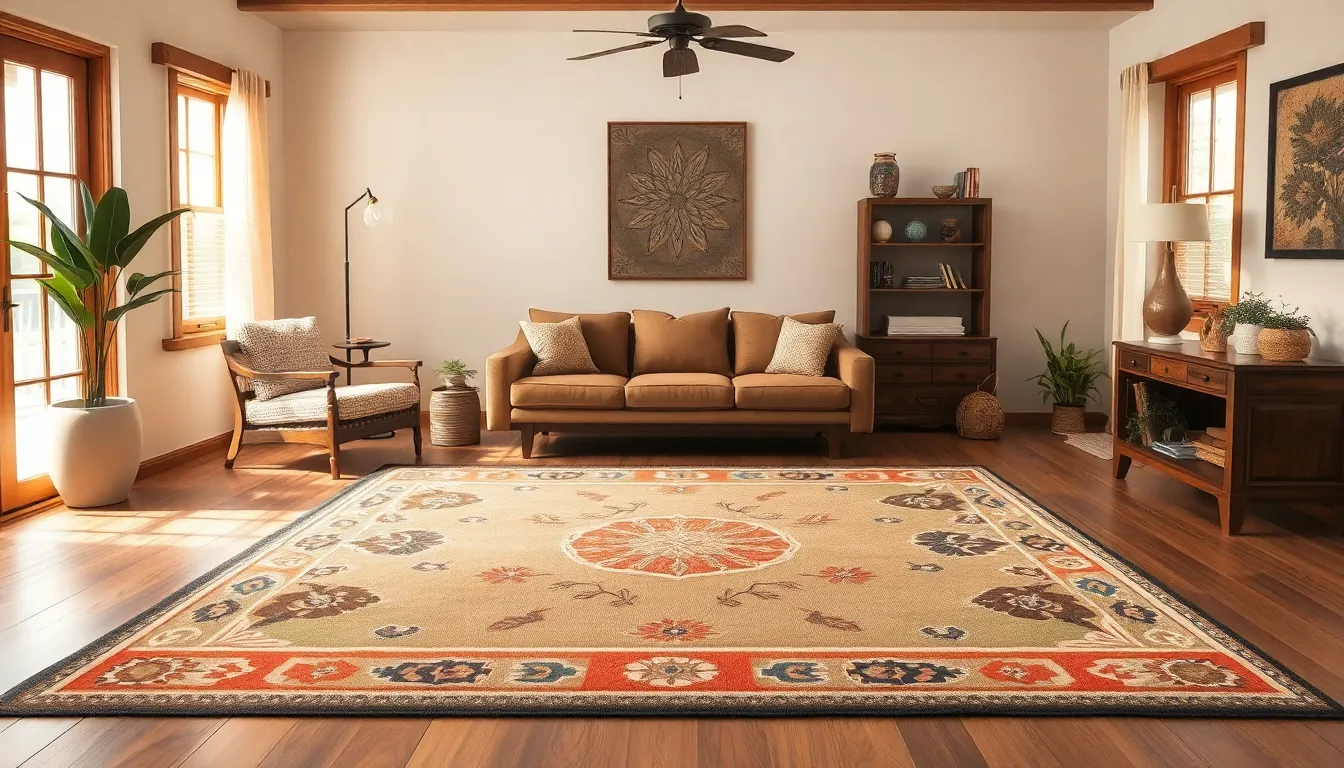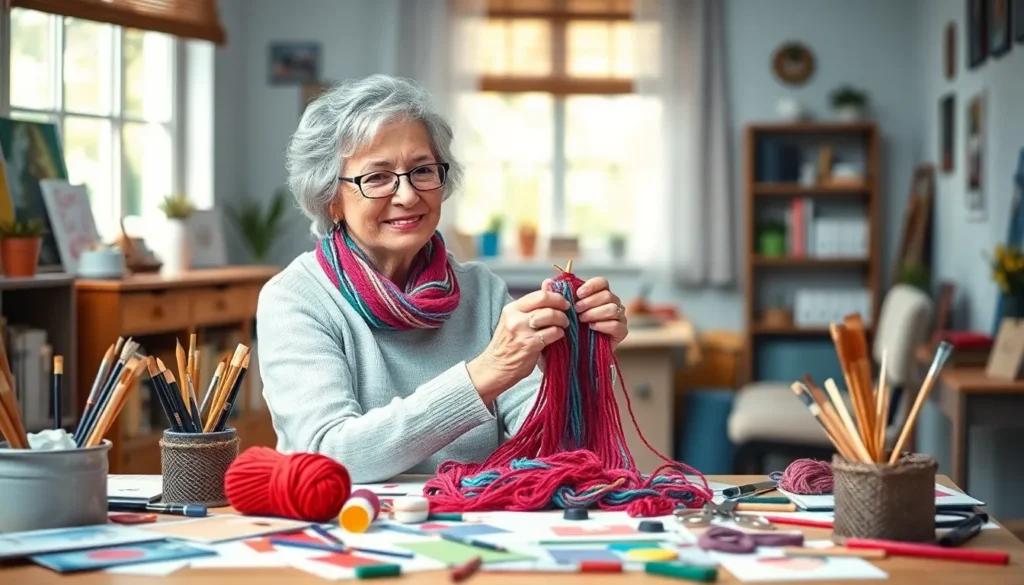Table of Contents
ToggleWhen it comes to home decor, nothing quite ties a room together like a stunning arts and crafts rug. These beauties don’t just sit pretty; they tell stories, spark conversations, and might even distract guests from that questionable stain on the couch. With their rich textures and vibrant patterns, arts and crafts rugs bring warmth and personality to any space, proving that style doesn’t have to be serious.
What Are Arts and Crafts Rugs?
Arts and crafts rugs represent a distinct design movement that prioritizes craftsmanship and natural materials. Characterized by their unique patterns and textures, these rugs often feature geometric designs and earthy color palettes. Artisans typically hand-weave these pieces, ensuring each rug embodies quality and individuality.
Often made from wool, cotton, or jute, these materials provide both durability and a tactile sensory experience. The use of natural dyes enhances the richness of colors, appealing to those who appreciate sustainable practices. Arts and crafts rugs serve not only practical functions but also bring a sense of artistry and tradition to home decor.
Classic designs often draw inspiration from nature, incorporating motifs such as leaves, flowers, and trees. Each rug conveys a specific aesthetic while allowing for personal expression in various spaces. Popular among homeowners and interior designers, these rugs create warm, inviting atmospheres.
Arts and crafts rugs often find homes in living rooms, dining areas, and bedrooms. Their placement can anchor a room’s design, providing visual interest and texture. Selecting the right arts and crafts rug can significantly impact the overall ambiance, making it an essential choice for interior decor enthusiasts.
History of Arts and Crafts Rugs

Arts and crafts rugs reflect a rich heritage rooted in craftsmanship and design. These rugs emerged as an integral part of the arts and crafts movement, which sought to revive traditional techniques and celebrate the beauty of handcrafted goods.
Origins in the Arts and Crafts Movement
The arts and crafts movement originated in the late 19th century, emphasizing a return to handcrafted artistry. Influenced by the growing industrialization of society, it aimed to counteract mass production’s adverse effects on quality and design. Popularized by figures such as William Morris, the movement promoted the use of natural materials and skilled labor. Rug makers embraced this philosophy, creating handmade pieces that featured geometric designs and natural motifs. Many artisans chose to work with wool and cotton, prioritizing both durability and aesthetic appeal. Patterns often drew inspiration from natural elements, reflecting the movement’s dedication to art and nature.
Notable Designers and Manufacturers
Several influential designers and manufacturers shaped the landscape of arts and crafts rugs. William Morris, a key figure in the movement, designed rugs that showcased intricate floral patterns and a deep appreciation for nature. His designs inspired many contemporaries and created a lasting legacy in textile design. Other notable names include Gustav Stickley, known for his commitment to quality craftsmanship and simple, functional designs. Companies like R.G. Smith and the Morris & Co. brand also contributed significantly by producing iconic rugs that embodied the principles of the arts and crafts movement. Each of these designers and manufacturers played a vital role in establishing the unique characteristics that define arts and crafts rugs today.
Characteristics of Arts and Crafts Rugs
Arts and crafts rugs display distinctive characteristics that reflect their artistic heritage. These rugs emphasize quality craftsmanship and natural materials, which enhance their appeal and durability.
Material and Construction Techniques
Hand-woven techniques dominate arts and crafts rugs. Wool, cotton, and jute serve as popular materials due to their resilience and texture. Natural dyes often color these materials, allowing for eco-friendly production methods. Craftsmen frequently adopt traditional weaving methods, ensuring each rug showcases unique craftsmanship. Emphasis on durability means these rugs withstand daily wear while maintaining their beauty and character.
Design Elements and Patterns
Geometric designs define the aesthetic of arts and crafts rugs. Simple motifs like leaves and flowers provide a connection to nature, making the designs visually striking. Color palettes often consist of earthy tones, reflecting the movement’s inspiration from the natural world. Each rug exudes individuality through the use of repetitive patterns and clean lines. The harmony of these design elements creates a cohesive look that enhances various interior settings.
Choosing the Right Arts and Crafts Rug
Selecting an appropriate arts and crafts rug enhances both style and functionality in a space. Key factors influence this choice, including design, material, and placement.
Considerations for Style and Aesthetics
Style plays a crucial role in choosing an arts and crafts rug. Consider the room’s existing decor and color scheme when selecting a rug. Geometric patterns and earthy tones should complement existing furniture or wall colors. Opt for a rug with natural motifs if aiming for a nature-inspired theme. Rug size significantly impacts visual balance in any room. An oversized rug can create a cozy feel while a smaller one might accent a specific area. Placement also affects aesthetics; a well-placed rug can serve as a focal point in a living room or dining area.
Care and Maintenance Tips
Caring for an arts and crafts rug ensures longevity and maintains its beauty. Regular vacuuming should remove dirt and debris, keeping the rug looking fresh. Spot cleaning with a mild detergent and water handles minor stains effectively. Avoid harsh chemicals that can damage natural fibers. Rotating the rug periodically helps minimize wear and fading from sunlight. Protecting the rug from spills is essential; using coasters under drinks or furniture prevents staining. Professional cleaning every few years can restore the rug’s vibrancy, ensuring it continues to enhance the home’s aesthetic.
Arts and crafts rugs stand out as timeless pieces that bring both beauty and function to any home. Their unique designs and natural materials not only reflect personal style but also contribute to a warm and inviting atmosphere. These rugs serve as a testament to skilled craftsmanship and the enduring appeal of handmade artistry.
By thoughtfully selecting and maintaining an arts and crafts rug, homeowners can enhance their living spaces while celebrating a rich design heritage. With their vibrant patterns and earthy tones, these rugs are more than just decor; they’re a meaningful addition that resonates with the essence of nature and creativity.







